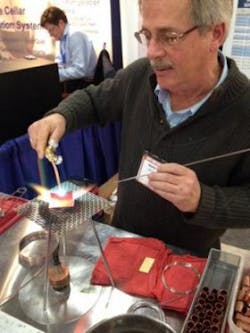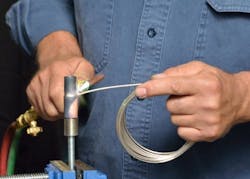Let’s talk a little about some basic techniques and procedures in torch brazing.
Pre-Cleaning
The formation of surface oxides on copper tube and fittings and other metals is unavoidable when these materials are exposed to the atmosphere. In order to maximize a good covalent bond between the brazed parts and the filler metal, these surface oxides must be removed, either chemically, or with an abrasive material or file. If there is a presence of oil or grease on the parts, it should be removed with a solvent prior to mechanical oxide removal. Cleaning of the parts to be brazed is very important because the presence of these oxides or contaminants can prevent the flow or capillary action of the molten filler metal at brazing temperatures. Many failures or leaks in brazed joints can be avoided by proper pre-cleaning of the braze assembly.
Temperature Matters
In the HVACR industry, the most widely-used braze joint is the joining of copper tubes and fittings. The primary brazing alloy used for this assembly is AWS BCup-5, commonly referred to as “15%”. NetBraze 15, or “15%”, is a favorite because of its wide melting range – solidus temperature 1190F and liquidus temperature 1485F. The advantage of a wide range of flow temperature is that it enables the operator greater control of the alloy during brazing. At the high end of the melting range the alloy flows thinner and is able to penetrate into the tightest areas of the joint assembly. By reducing the temperature during brazing, the alloy flows thicker and can fill wider gaps while creating a cap or fillet on the assembled joint.
Proper Heating
When brazing a copper tube and fitting, it is a good practice to concentrate the heat on the tube first so that the heat is conducted through the copper into the interior of the assembly. After the tube has been preheated, then alternate heating the fitting and the tube to bring both pieces up to brazing temperature at the same time. In order to get a strong covalent bond on all surfaces to be joined, the parts of the assembly need to be uniformly or simultaneously heated to brazing temperature when the brazing alloy is applied. When all parts are up to the proper temperature the filler metal can flow without restriction and bond with the base metal in a very short amount of time. Prolonged heating cycles and overheating can cause serious problems in the brazing process.
Alloy Content
The phosphorus content of the BCup alloys permits copper-to-copper brazes to be accomplished without the use of a brazing flux. In general, when brazing copper to brass, a brazing flux is required. There are, however, certain conditions and exceptions where copper and brass can be joined without using additional flux.
We have created several new, patent-pending silver solder alloys that flow at record-breaking low liquidus temperatures, while offering economic advantages of lower silver content. There is a wide variety of silver solders or high silver alloys designed for use with ferrous and other metals outside of the copper family. Alloy selection depends on factors such as brazing temperature, base metals used, joint design and function of end products.
Using Flux
When brazing flux is required, it should be applied after pre-cleaning of the assembly. Apply flux to cover the entire surface area of the parts to be joined. Brazing flux does remove contaminants in the joint area during brazing, but more importantly, it covers the metal surfaces at elevated temperatures to prevent the formation of oxides during brazing. The presence of surface oxide prohibits capillary action (flow) and bonding of the molten filler metal with the base metals. When the braze assembly is overheated, the flux is burned and forms hard crystalized carbon contaminants that cannot be displaced, causing flux entrapment and poor coverage of the filler metal in the joint area.
Operator Attention is Key
All of these considerations – pre-cleaning, liquidus temperature, alloy content, proper heating and the use of brazing flux are primary concerns. However, the most important factor in the brazing process is the focus of the brazing operator. Always consider each aspect of the brazing process before you begin.
NetBraze LLC is a manufacturer of phos-copper/silver and high silver brazing filler metals and fluxes. Our family-run manufacturing plant is located in Mount Orab, Ohio, just east of Cincinnati. NetBraze is highly dedicated to innovation and bringing advantages to those who use our products. We are now producing phos-copper silver alloy in the form of a coil – *QuickCoil – that reduces waste during application. For more information or to comment, e-mail [email protected]











